25 of the Best Christmas Horror Movies

What exactly is it that compels the proliferation of Christmas-themed horror movies over the years? Is it the inherently transgressive nature of bloodying a holiday that is meant to represent joy, peace on Earth, and goodwill toward men? It is, after all, all too conceptually easy to set a horror film on Halloween, a day when the evil forces on Earth are expected to roam free. Setting a bloodbath against the pristine, jealously guarded specter of Christmas, on the other hand, has always been angling for a certain level of purposeful offense, because there have always been starched collar folk who take the defense of the holiday’s image very seriously. Perhaps tearing down that institution (or at least gently ribbing it) is simply too tempting to resist.
Regardless of the why question, though, Christmas has been a fertile ground for horror cinema for half a century, with entries going back at least as far as 1972’s Silent Night, Bloody Night, and arguably including every adaptation of Charles Dickens’ A Christmas Carol. Along the way, there have been classics like Bob Clark’s deeply influential Black Christmas in 1974 (already rebooted twice now, with lesser results), and an innumerable array of cinematic coal lumps and bad puns, from Santa Claws to Santa’s Slay.
In the spirit of the season, please enjoy this starter collection of Christmas horror classics, along with a few entries of the “so bad they’re good” variety. Please note: We figured A Nightmare Before Christmas was probably too much of a gimme (and not really “horror”), so you won’t see it here. And then, once you’re ready to go deeper and dumber, check out our picks for the worst Christmas movies of all time. You may notice a little crossover.
Here are the 25 best Christmas horror movies:
25. Silent Night, Deadly Night Part 2 (1987)
Director: Lee Harry

A film that both typifies the sequel-laden late ’80s slasher genre and illustrates its pitfalls, the woeful Silent Night, Deadly Night Part 2 is known more today for its infamous “garbage day!” meme fodder than anything else. As a sequel highly constrained by budget, it spends the vast majority of its runtime simply re-hashing footage from the run-of-the-mill original installment of this “killer Santa Claus” franchise, but it’s the sequences of Part 2 that venture off onto their own that truly make it an absurdist camp classic. In particular, actor Eric Freeman as serial killer “Ricky” leaves an unforgettable impression for how genuinely and haplessly out of his depth he appears to be throughout. It’s a bad performance for the ages—Freeman’s stilted and hesitant delivery of what are meant to be the menacing words of a psychopath can never hide the clear anxiety written on his face through every frame. As the film runs on, there’s an increasingly surreal thread that worms its way to the surface, exemplified by the scene wherein Ricky goes to a movie theater and somehow manages to watch segments from the first film on the screen, despite the fact that the original killer was supposed to be his brother. If you’re programming a “bad Christmas movies” lineup, Silent Night, Deadly Night Part 2 is essential viewing. —Jim Vorel
24. The Gingerdead Man (2006)
Director: Charles Band
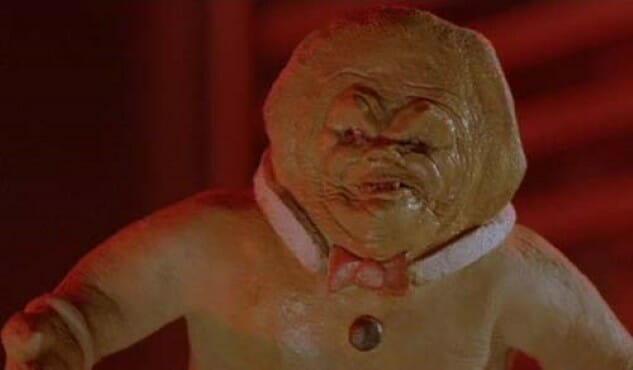
Like just about anything else from director Charles Band’s Full Moon Entertainment, The Ginderdead Man looks like it was made on a wing, a prayer and a budget that can barely be said to exist at all. But at a mere 75 minutes, and with the promise of a deranged Gary Busey as the title character, we’re willing to look past a lot. A highly Child’s Play-derivative film that is lighter on the overt Christmas theming than some other holiday horror movies, it compensates with sheer, stupid gusto. Busey plays a mad dog killer who was executed via the electric chair, cremated, then has his ashes secretly mixed into a batch of gingerbread spices, whereupon he rises from the dead as a homicidal cookie with disturbingly Busey-esque features. His voice has zero of the charm that someone like Brad Dourif brings to his many appearances as Chucky, but you already knew that—you’re here to watch Busey disconnect from reality and cackle to himself constantly, while occasionally severing the odd digit or limb. The film moves pretty slowly, but the blood effects aren’t half bad—and they don’t get much shorter than this. If bad Busey performances are your guilty pleasure, it’s a holiday must. —Jim Vorel
23. Elves (1989)
Director: Jeffrey Mandel
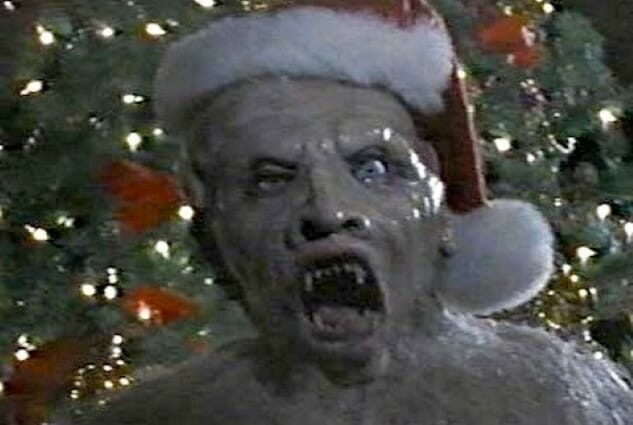
Doubtlessly an automatic blue chip selection when it comes to “fun bad” Christmas horror movies, Elves manages to take what could have been a comfortably familiar 1980s horror premise (Gremlins, except even more Christmas-y) and distills it into a far more bizarre tincture of insanity. I mean really—with even a modicum of a budget and some decent puppets, you could make a competent version of “Santa’s elves are evil and they kill people,” but Elves lacks even the most basic FX work, which makes its completely inarticulated antagonists even funnier. They all look like they’re stuck in mid-sneeze, and have to be physically thrown by someone offstage when “attacking” the protagonists. Factor in the revelation that the elves are actually the result of Nazi genetic experimentation, in an effort to create “a pint-sized master race,” and you’ve got a bonkers premise for the ages. Dan “Grizzly Adams” Haggerty stars as a pathetic, alcoholic mall santa/ex detective who must save the day via such activities as looking up “elves” at the library and barging into a professor’s Christmas dinner so he can ask about elf sex in front of his watching family. Suffice to say, there are jaw-dropping moments aplenty. —Jim Vorel
22. Santa’s Slay (2005)
Director: David Steiman
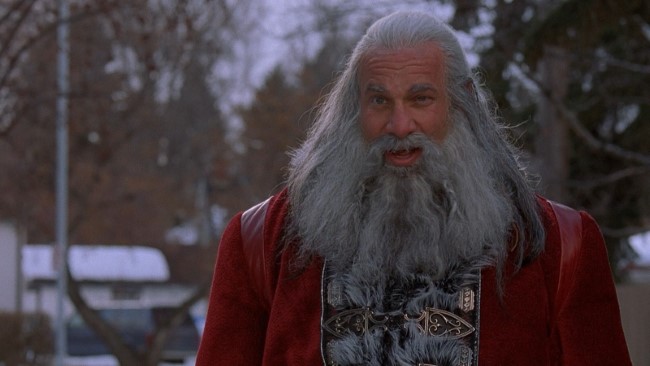
This list is replete with killer Santas of every variety, but none of them are quite as swollen with muscle and bravado as former WCW World Heavyweight Champion Bill Goldberg, and surely that must count for something. Santa’s Slay is well-calculated trash, instantly familiar and bereft of a single new idea of any kind, but simultaneously so cheerfully executed that you’re tempted to just give it a pass. At the very least, Goldberg certainly aces the physicality required of the character, playing an evil Santa who we learn is in fact a son of Satan or form of the Antichrist, who lost a bet against an angel 1,000 years ago and was subsequently forced to deliver presents for a millennia. When that deal finally runs out, though, Santa returns for vengeance on all of mankind, fully prepared to dropkick people through windows or run them down with his massive “hell deer.” Santa’s Slay peaks pretty much instantly, aping the likes of Sam Raimi in a Christmas family dinner massacre that is so over-the-top, the rest of the film has little place to go but down. There’s no denying this is a particularly obnoxious entry in the Christmas horror canon, and never does it make a genuine attempt to frighten its audience, but it’s hard to care when you see the film’s star clearly having the time of his life playing the character. —Jim Vorel
21. Jack Frost 2: Revenge of the Mutant Killer Snowman (2000)
Director: Michael Cooney
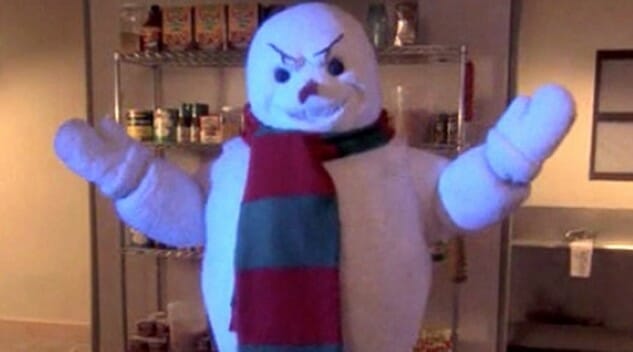
The only reason that 1996’s original killer snowman movie, Jack Frost, isn’t on this list is that the sequel is even more insane. Previously dissolved by antifreeze in the first movie, Jack Frost is reborn—thanks to a spilled cup of coffee—with new powers, including the ability to split into a pack of carnivorous snowball children, ‘ala Critters. Shockingly low-budget, the film is anything but sincere, but it still attempts to be both funny and scary at times while visually looking like a high school film project. It has that uniquely tawdry visual quality that you can only find in films that have been shot on video with absolutely nothing in the budget for video editing. If The Days of Our Lives ever did a killer snowman episode, this is what it would look like. Bonus: Because the snowman was recreated in part with the hero’s DNA, he shares various traits with him … including a banana allergy. Which means that the killer mutant snowman’s only weakness is bananas. Clearly, you’re in for a goofy good time here. —Jim Vorel
20. Silent Night, Bloody Night (1972)
Director: Theodore Gershuny
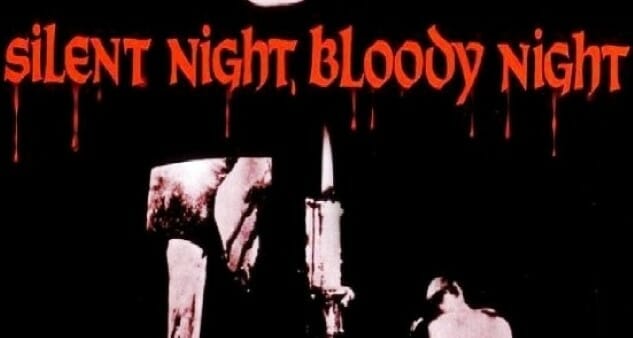
Grainy, low budget and objectively on the bleak side, Silent Night, Bloody Night isn’t nearly so well known as the similarly titled Silent Night, Deadly Night, despite pre-dating it by 12 years. Likewise, this film didn’t attract the kind of attention and outrage that Deadly Night engendered, presumably because it at no point features a killer Santa Claus, although the story is set around the holiday. With an unusual mix of elements, it heavily presages certain aspects of the slasher genre while also containing quite a bit of seeming giallo influences. There’s a mystery killer in black leather gloves, for instance, although some of the short “killer’s POV” shots evoke the pioneering work that John Carpenter would crystalize in Halloween. So too do the killer’s threatening phone calls remind one of the similar calls in Bob Clark’s Black Christmas two years later, although this film’s script is truly nonsensical in comparison. Still, the axe murders are suitably graphic, and the central killer performance is more than a little creepy. You just have to put up with a whole lot of nothing to find the nuggets of good in there. With a cast that is mostly notable today for being filled with Warhol Superstars like Mary Woronov, you almost wonder if he secretly directed the film as well for how committedly weird it is in editing and dialogue. Still, this is a film that helped pioneer the idea of “Christmas horror,” along with the same year’s Tales From the Crypt. —Jim Vorel
19. P2 (2007)
Director: Franck Khalfoun
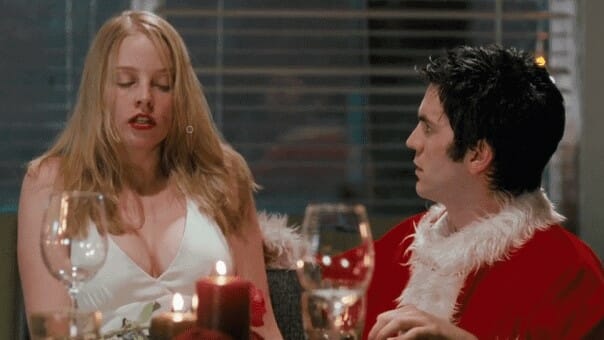
P2 is one of those concepts that could absolutely function in exactly the same way if set at any time of year, but simply had “Christmas” bolted on somewhere along the way as a little extra audience incentive. It’s fine, though—this isn’t the kind of flick that bears overanalysis. More or less a stalk-the-girl cat and mouse game from the start, P2 stars Rachel Nichols as a career-minded woman who works late in her office on Christmas Eve, only to find herself trapped in the building’s parking garage overnight, which just so happens to be manned by a security guard who has become obsessed with her. Directed by Franck Khalfoun, who brought us the 2012 remake of Maniac starring Elijah Wood, P2 aspires to none of the same artiness or provocation—it’s merely a potboiler “woman fights for survival” film, albeit a fairly slick one. Wes Bentley, thankfully, is always happy to give his all to the portrayal of a psychologically disturbed scumbag calculated to make the audience’s skin crawl. —Jim Vorel
18. Silent Night, Deadly Night (1984)
Director: Charles E. Sellier Jr.
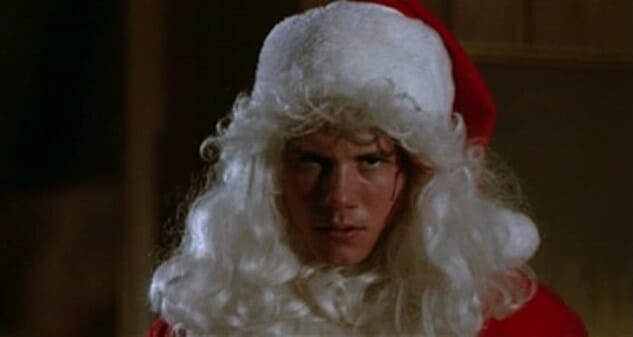
It’s funny to think what a commotion this film managed to make in 1984, despite the fact that its content was really in no way different than standard slasher fare of the time—a textbook example of a hysteria or moral panic being thrown up around a film by people who were unaware that the same “unwholesome” material had been depicted numerous times before. In particular, detractors were enraged by the fact that Silent Night, Deadly Night was besmirching the hallowed figure of Santa Claus by making a slasher killer in his image, but the same depiction of a killer Santa had already been in several films beforehand, including 1972’s Tales From the Crypt and both 1980’s Christmas Evil and the same year’s To All a Goodnight without inspiring similar headlines, picketing and boycotts. This time, however, the fervor around the film’s release resulted in TriStar pulling all ads for the movie only six days after its initial release, ultimately resulting in a lackluster box office, and an impact that was more cultural than literal.
This was all ultimately that much sillier for the fact that, in all reality, Silent Night, Deadly Night is a fairly harmless entry in the golden age slasher canon. It makes a semi-serious attempt at a psychologically driven backstory for killer Billy, who witnessed his parents’ murder by a man dressed as Santa Claus, but then quickly (and thankfully, really) transitions into a spate of classic slasher killings—none better than the kid who gets beheaded by an axe-wielding Santa while sledding. Today, the famously abysmal sequel is likely the better-known film of the two, but the original is easily the stronger (if not necessarily more memorable) film. Certainly, it proved influential upon the many, many killer Santa movies that would follow. —Jim Vorel
17. Pooka! (2018)
Director: Nacho Vigalondo
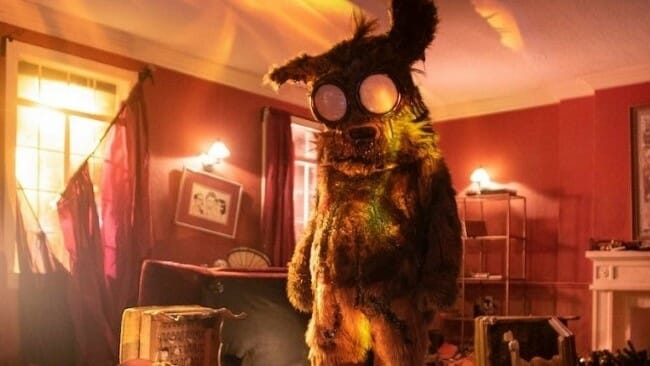
Talented Spanish sci-fi/weird fiction director Nacho Vigalondo (Colossal) turned his eye toward the Christmas holiday in this off-kilter entry in Hulu’s Into the Dark horror anthology series, in which a struggling actor is hired to portray the man-in-a-suit version of hot new Christmas doll Pooka, only to find that the big, fuzzy suit may have a mind of its own. Functioning something like a Vigalondo tribute to the claustrophobic, psychological meltdowns of Roman Polanski, especially Repulsion and The Tenant, Pooka! offers up apocalyptic visions, albeit on a shoestring budget. It’s eventually revealed to harbor some of the same mobius strip logic as Vigalondo’s earlier Timecrimes, but mostly gets by on solid performances despite a lack of production value. Zimbabwean-British-American actor Nyasha Hatendi in particular helps carry the film above its “TV movie” trappings. —Jim Vorel
16. Silent Night (2021)
Director: Camille Griffin
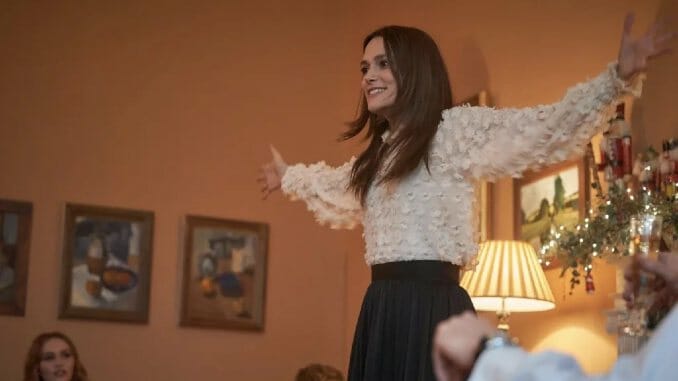
From its opening sequence, which plays over a campy Christmas anthem called “The Christmas Sweater” (one that could only be dreamt up by Michael Bublé), Silent Night sets out to be deceiving. As our upbeat jingle merrily chimes in the background, we meet a quirky cast of characters who are all on their way to a Christmas dinner hosted by well-to-do couple Nell (Keira Knightley) and Simon (Matthew Goode). As most Christmas ensemble flicks go, each person has their own set of problems. Sophie (Lily-Rose Depp), for example, is much younger than the rest of the guests, and is worried that she won’t fit in. Sandra (Annabelle Wallis), on the other hand, is bored by her husband Tony (Rufus Jones), and is secretly pining after her childhood best friend, James (Sope Dirisu). As the cavalry approaches the house, there’s no doubt to be had that we’re in for a good ol’ Christmas romp, and that misadventures galore are bound to follow. But none of our guest’s problems are more dire than the chief problem at hand: The world is just hours away from being consumed by lethal gases caused by global warming. To save them from suffering, the English government gives citizens “exit pills” which ensure a quick and painless death. This reveal, which comes at the end of the first act, is surprising, especially as it is announced in such a lighthearted way: Nell ends a toast by saying “May we all rest in peace.” From that point forward, the film metamorphoses into a dark comedy that flip-flops between genuine horror and dry, quirky humor. —Aurora Amidon
15. Christmas Evil (1980)
Director: Lewis Jackson
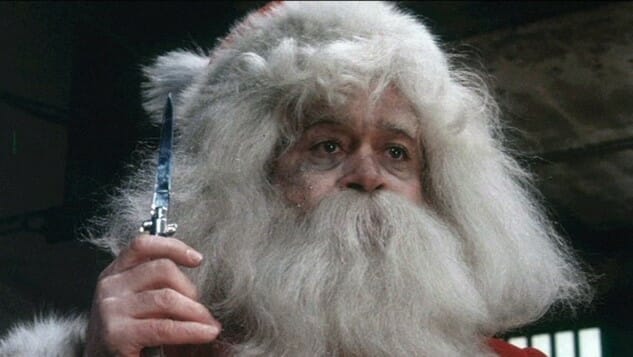
Christmas Evil sounds like a derivative slasher, but it’s so much weirder than that. In fact, it predates Silent Night, Deadly Night as the first of the feature-length “killer Santa” movies, and it’s also much more disturbed. A man is literally driven insane as a child when he sees Mommy performing sexual favors on Santa Claus, so the film naturally then fast-forwards about 40 years to this sad, middle-aged loser (Brandon Maggart) who works at a toy factory and spends his time at home dressing up as Santa and spying on the neighborhood children. Weirdly, he’s an almost completely sympathetic character for the first two-thirds of the film before he starts killing folks for no good reason, culminating in what is, with no hyperbole, one of the most unexpected, WTF endings in film history. I won’t spoil it. Just watch, with the knowledge that up to this point, the film has made pains to be completely “realistic.” The ending is of course the star of the show, but it’s by no means the only bizarre sequence. Case in point: After committing his first murder, Santa is wandering the street when he gets pulled into an office party. He then spends literally five full minutes of screen time playing with the children and dancing before taking his leave. It has no bearing on the plot of any kind. It’s just another head-scratching moment in one of the Christmas season’s most off-kilter horror features. —Jim Vorel
14. The Leech (2022)
Director: Eric Pennycoff

Eric Pennycoff’s The Leech is yet another character-driven horror film shot under COVID-19 pandemic conditions. Pennycoff works well enough within the parameters of the restrictions, drawing tension and darkly blasphemous humor from many an unholy night. It’s a slower burn, as good samaritan morals lead to an explosion of violent Christmas horrors, and not without its lulls. That said, Pennycoff still finds a way to sustain religious commentaries as greed, gluttony and other sins break through the silence.
Graham Skipper stars as Father David, a devout priest with a barren flock who posts homily wisdom on Facebook. After service one day, he finds the disheveled-looking Terry (Jeremy Gardner) sleeping in a pew. Terry tries to crash in the church for the night, then accepts a ride home from David—where his belongings have been tossed outside by his now less-significant other. David remembers God’s teachings and opens his home to Terry, giving the derelict a warm bed, a private room and other amenities. He’s met with gratitude and humbleness from Terry, but that quickly morphs. David thinks he can save Terry—a man he knows nothing about, who starts taking more and more from David by the day. The Leech earns its title because that’s what Terry is—a drifter who snatches a golden opportunity and drains its host dry. —Matt Donato
13. Sint (2010)
Director: Dick Maas
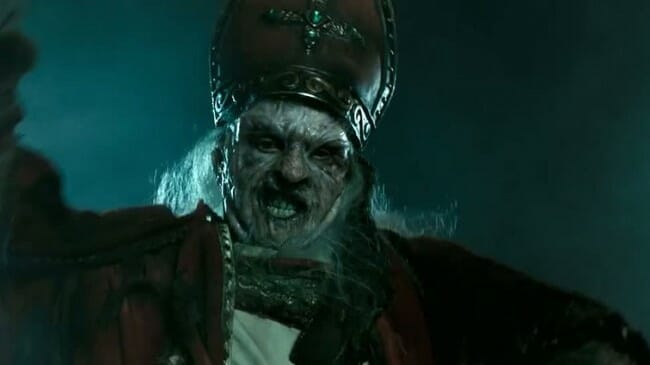
Before Michael Dougherty had turned his attention to Krampus, pioneering Dutch horror director Dick Maas had already evoked some of the same European holiday horror via Sint, released as Saint or Saint Nick in the U.S. A dark comedy horror film with an equally nihilistic streak to Krampus, the film reimagines the traditional portrayal of Santa by mixing it up with the original characterization of Sinterklaas, the Dutch legend upon which the character is largely built—here, Sinterklaas was originally a fallen bishop who became the leader of a murderous gang of criminals and thieves, before he was rounded up and executed by the peasantry. Naturally, though, he swore to return and enact supernatural vengeance, leading to a plot that is a bit like a Christmas-themed twist on John Carpenter’s The Fog. Boasting some strong effects work, it’s a charmingly uncomplicated holiday horror yarn. —Jim Vorel
12. A Christmas Horror Story (2015)
Directors: Grant Harvey, Steven Hoban, Brett Sullivan
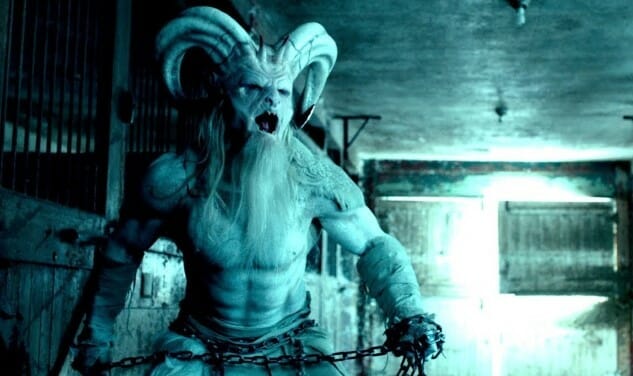
A Christmas Horror Story seems more or less like an attempt to manufacture an anti-seasonal classic for Christmas in the vein of Michael Dougherty’s Trick ‘r Treat for Halloween, pulled off with a partial degree of success. Although this anthology lacks the warmth and true sense of appreciation for the holiday that makes Trick ‘r Treat such an easy film to love, its stories do benefit from being pretty uniformly well cast and acted. The choice to have them all unfolding simultaneously arguably hurts the film’s coherence, however, especially in the sense that one of them (Santa fighting zombie elves, suitably amusing) is in completely different tonal territory as an Evil Dead 2-style horror comedy, in comparison with the serious, grounded approach of several others. Nor do the stories really link up in a substantive way, save for a bit of last-minute trickery, but in terms of pure execution in each self-contained tale, A Christmas Horror Story does overcome a meager budget. Admit it: You always wanted to see Santa dismembering his elves anyway. —Jim Vorel
11. Anna and the Apocalypse (2017)
Director: John McPhail

This sometimes confusing, sometimes endearing genre mish-mash is one part zombie comedy and one part high school musical, but has a tendency to throw itself entirely into one or the other until you’ve forgotten quite what it is you’re watching. Anna (Ella Hunt) is a British teen looking to toss her “uni” plans aside and live abroad for a while—plans that are derailed by the sudden holiday arrival of what certainly seems to be a zombie apocalypse. Peppered with hyperkinetic song-and-dance numbers that have a decidedly Broadway vibe, the film starts a bit slow, feeling for all intents and purposes like a lost entry in Disney’s High School Musical series before it blooms in its second and third acts into a surprisingly satisfying (and plenty gory) zombie-slaying farce. Capable of more pathos than you’d give it credit for, Anna and the Apocalypse tosses most character archetypes aside and can boast a few genuinely toe-tapping numbers, especially once the world has gone to hell. It’s a film you may need to warm up to, but Game of Thrones fans will enjoy the presence of Paul Kaye, one Thoros of Myr, as the school’s draconian principal. —Jim Vorel
10. Christmas Bloody Christmas (2022)
Director: Joe Begos
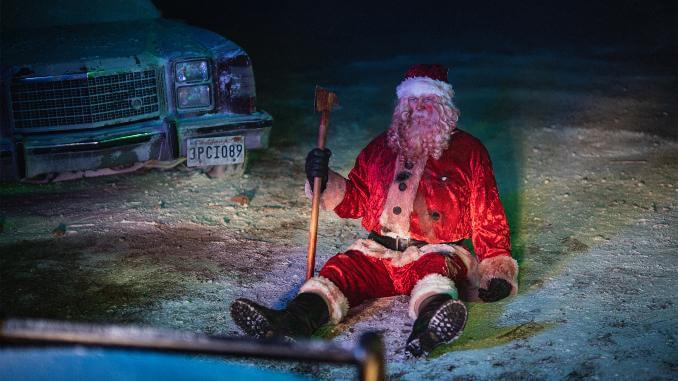
If you’re here for overdetermined commentary on seasonal goodwill, you’ve come to the wrong place. If you’ll accept a fire ax to the face in lieu of fellowship, though, Begos will provide. Christmas Bloody Christmas wrangles a whole lot of faces for chopping and, this being the slasher’s core entertainment, the movie succeeds. Somewhere amidst the butchery, Begos sneaks in jabs at the military industrial complex’s outsized presence in civilian life and the consequences of American jingoism; his antagonist isn’t the “real” Claus but a robo-Santa—a decommissioned army android retired from slaughtering the nation’s enemies abroad and refurbished as your friendly neighborhood toy-store display. Of course robo-Santa (Abraham Benrubi, a man born to give hugs) glitches out. Of course robo-Santa starts tromping around town hacking people to pieces. ‘Tis the season. —Andy Crump
9. The Advent Calendar (2021)
Director: Patrick Ridremont
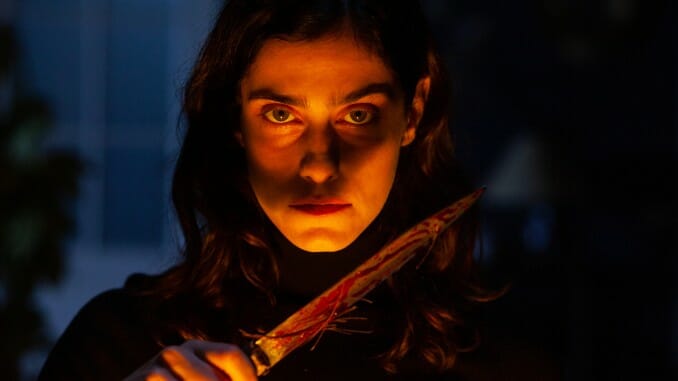
Patrick Ridremont’s The Advent Calendar kickstarts the Christmas horror season by demonizing an otherwise innocent holiday tradition. That’s when festive frights are at their best, after all. Gingerbread men become ninja assassins, or a wooden box filled with 24 treats—one per pre-Christmas December day—summons a connected evil. Spoken in French, as influenced by German lore, The Advent Calendar releases a Silent Hill-inspired genie that’ll grant your wishes through magic chocolates with sacrifices aplenty. Ridremont succeeds in crunching bones and raising hell, all with a seasonal waft of cloves and corpses from behind a wishgiver’s crooked smile. It’s chilling, teeters between moral stances and is a hellish-jolly greeting that should please horror fans in the mood for merriness gone malevolent. —Matt Donato
8. I Trapped the Devil (2019)
Director: Josh Lobo

Merry Christmas! Have some family dysfunction and possibly an untimely visit from the Prince of Darkness. The man locked up in Steve’s (Scott Poythress) basement might well be Satan himself. He might also be an innocent man, or at least a man innocent of being the devil, but Steve’s brother, Matt (AJ Bowen) and sister-in-law Karen (Susan Burke) don’t really know what to make of Steve’s situation. Is he deluded, or still grieving a loss that at first goes unspoken and later is made explicit? Or does he really genuinely have Old Scratch imprisoned in his home? Director Josh Lobo toes the slow-burn line, doing very little at the start to meaningfully terrify viewers, but he rapidly layers I Trapped the Devil with mood and dread, his finger looped through the pin of a grenade in every interaction Steve has with Matt and Karen, as if at any moment their tentative atmosphere could descend into straight-up chaos. The film’s central question hangs over all until, at long last, Lobo gives an answer, but the answer is so chilling that we might wish he’d kept us in the dark all along. —Andy Crump
7. Deadly Games (1989)
Director: René Manzor
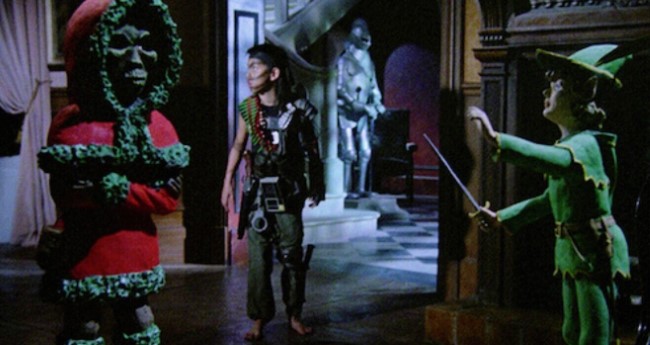
Also known under the memorably odd title of 3615 code Père Noël, Deadly Games is a borderline inexplicable French relic of Christmas action-horror history that has only more recently become better known among English-speaking genre geeks. You’d be tempted to say that there’s nothing else like Deadly Games, nothing that one would compare it to, except for the fact that there is one very similar touchstone: Chris Columbus’ Home Alone. Yes, Deadly Games is also about a young, creative and sardonic boy defending his home from invaders during the holiday season, but where the comic violence of Home Alone (which arrived one year later, suspiciously) is calculated for laughs, held at distance from the devastating real-life effects of say, being smashed in the face by an iron, Deadly Games actually embraces the bloodshed. Nor is this kid being menaced by a pair of bumbling burglars, but instead a mentally deranged drifter who has taken on the guise of Santa Claus after intercepting the boy’s attempt to call Father Christmas at the North Pole. This is all exactly as bizarre and surreal as it sounds–imagine if the Wet Bandits were carving their way through a trail of bodies in order to get to Kevin, and you’re starting to get close to the unique vibe of Deadly Games. I would say it’s the only Christmas horror movie to involve a person hiding within a suit of medieval armor at some point … except for the fact that this also happens in 1980’s To All a Goodnight. Christmas horror, you’ve got to love it.
6. Better Watch Out (2016)
Director: Chris Peckover

Attractively directed and shot, but wonkily scripted, Chris Peckover’s Better Watch Out puts a twist on the tropes of home invasion horror while simultaneously lashing itself to the Christmas holiday as an additional framing device. Its central twist and gimmick display a fair bit of promise, which I won’t spoil here, except by saying that it’s a challenging role for young actor Levi Miller, who can’t quite match leading lady Olivia DeJonge as the resourceful babysitter-in-peril. It’s also clearly intended as a rather searing portrait of toxic masculinity, latent sociopathy and the internet era’s caricature of the so-called “nice guy” archetype, which it doesn’t exactly handle with much subtlety. At its weakest, the contrived plans of Better Watch Out’s antagonist have a tendency to beggar belief in their overwrought complexity, but when it’s able to simply let its characters bounce off each other, it proves surprisingly effective. That goes doubly for when the blood starts flowing in disturbingly realistic fashion. A tonal upheaval by design, the film is not always on point, but it’s easy to admire the effort, particularly when the gore is appropriately visceral. —Jim Vorel
5. Krampus (2015)
Director: Michael Dougherty
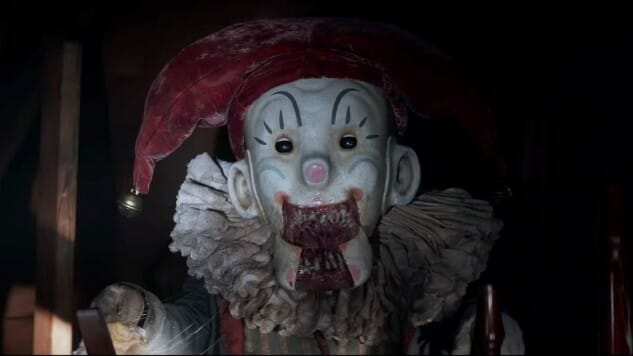
Krampus begins on a fantastically sour note. Bing Crosby’s “It’s Beginning to Look a Lot Like Christmas” plays during the film’s opening credits sequence as consumers pummel one another all in the name of a good Christmas bargain. Women get punched in the face, children scream and store employees stare on in slack-jawed apathy. It’s clear from these opening moments that director Michael Dougherty has his tongue planted firmly in cheek. Krampus is a horror film, filled with horrific imagery (it’s one of the harshest PG-13 films in recent memory), but it also has a solid sense of humor, albeit a nasty one. In fact, Krampus owes a lot to Joe Dante’s Gremlins: Both films inject the holiday with zany violence, and Krampus, in the spirit of Gremlins, makes heavy use of practical effects over CGI. The actors (Adam Scott, Toni Collette, Allison Tolman, David Koechner) fight with actual, physical creations, and as a result the terror seems more realistic and brutal. Dougherty, after all, is no stranger to holiday-themed horror comedies—he also directed the superb Halloween horror anthology Trick ‘r Treat—which means we’ve maybe got a new anti-Christmas classic on our bloody hands. —Andy Herren
4. Tales From the Crypt, segment “… And All Through the House” (1972)
Director: Freddie Francis
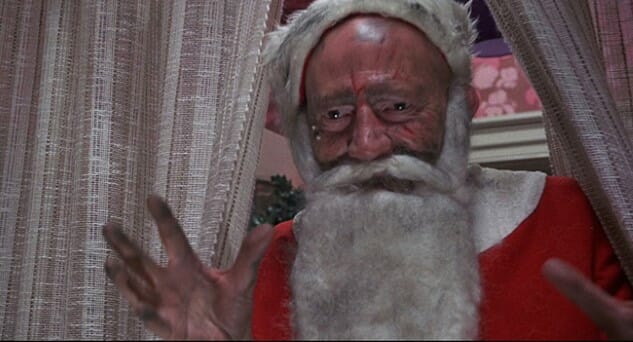
We’ve hit on a lot of other “killer Santa” entries on this list, as you no doubt knew we would, but we’re now ready to argue that the original is arguably the best. This is, as far as we know, the first cinematic depiction of Father Christmas/St. Nick as a frothing psycho, and it benefits from its conciseness: As a single segment in a larger anthology film, “… And All Through the House” can simply present a realistic (and horrific) scenario in progress rather than attempt to pad itself out with feature-length characterization.
The story concerns a put-upon wife (Joan Collins) who chooses to murder her clueless husband (Martin Boddey) on Christmas Eve, staging the death to look like an accident. At the same time, however, an escaped lunatic from a local asylum (Oliver MacGreevy) chooses just that moment to pay the home a visit, and wouldn’t you know it—he’s picked up a very recognizable costume along the way. This version of the “killer Santa” is considerably more menacing than those that make the “real-life” Santa into a killer, precisely for the fact that we have so little idea of what’s going on behind his vacant expression. We don’t even really know if he understands the significance of the suit he’s wearing. A suspenseful cat-and-mouse game ensues, as our quasi-protagonist (who is a murderer herself, mind you) must fend off the attacker rather than call the police, lest her own crimes be discovered. It’s by far the high point of this original adaptation of the EC Comics staple Tales From the Crypt, and would go on to be remade as an episode of the beloved 1990s Tales From the Crypt series on HBO, directed by Robert Zemeckis. —Jim Vorel
3. Gremlins (1984)
Director: Joe Dante

In the same vein as Die Hard, Joe Dante’s Gremlins is a yearly Christmastime argument waiting to happen: Both are annually tossed onto “best Christmas movie” lists, but when it comes to the latter, at least, those debates often overlook the dark comedy of an expertly crafted ’80s horror film from Dante at the height of his powers. Taking the lessons he learned as a ’70s Roger Corman protege, Dante borrows character actors like Dick Miller to create a cynical, biting rebuke of maudlin sentimentality and children’s entertainment. The film’s surprising counterpoint between comedy and graphic violence was a source of consternation that matriculated it into the early class of genre films that led to the PG-13 rating, but its more important impact was shaping the aesthetic of nearly every horror comedy to come. —Jim Vorel
2. Rare Exports: A Christmas Tale (2010)
Director: Jalmari Helander
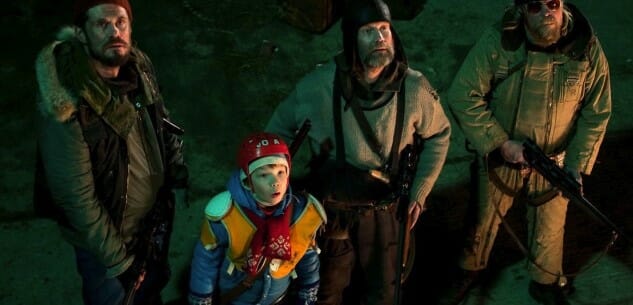
Of all the films that have attempted to tackle Christmastime mythology through the lens of horror, none have done it with half the gonzo weirdness of Finland’s Rare Exports. Although the subject of Krampus became popular horror fodder in the back half of this decade, the Fins were definitely laying some foundations here, dredging up the figure of Joulupukki, the so-called “Christmas goat” of Scandinavian folklore, who like Krampus punishes wicked children for their sins instead of dispensing candy and gifts. We see this particular story through the eyes of rural Finnish kids and their destitute parents, their livelihoods trampled by the engine of economic progress and consumerism, in a message that reflects the cynicism of Joe Dante’s Gremlins. It seems fitting, then, that it’s a government research team that dredges up horrors from beneath the crust of the Earth, representing the greed of adult children as they do. With a magical Nordic setting that perfectly suits its fantastical vibe, Rare Exports settles in alongside chilly, Scandinanvian horror contemporaries such as Let the Right One In or Dead Snow, although it never strives for the emotion or gravity or the former. It does, however, build to a formidable conclusion, giving us perhaps the most oddly unique origin story for Santa Claus that has yet been brought to the horror genre. —Jim Vorel
1. Black Christmas (1974)
Director: Bob Clark
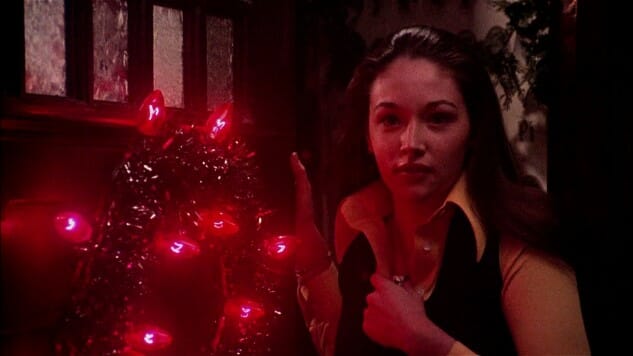
Fun fact: Nine years before he directed holiday classic A Christmas Story, Bob Clark created the first true, unassailable “slasher movie” in Black Christmas. Yes, the same person who gave TBS its annual Christmas Eve marathon fodder was also responsible for the first major cinematic application of the phrase “The calls are coming from inside the house!” Black Christmas, which was insipidly remade in 2006, predates John Carpenter’s Halloween by four years and features many of the same elements, especially visually. Like Halloween, it lingers heavily on POV shots from the killer’s eyes as he prowls through a dimly lit sorority house and spies on his future victims. As the mentally deranged killer calls the house and engages in obscene phone calls with the female residents, one can’t help but also be reminded of the scene in Carpenter’s film where Laurie (Jamie Lee Curtis) calls her friend Lynda, only to hear her strangled with the telephone cord. Black Christmas is also instrumental, and practically archetypal, in solidifying the slasher trope of the so-called “final girl.” Jessica Bradford (Olivia Hussey) is actually among the better-realized of these final girls in the history of the genre, a remarkably strong and resourceful young woman who can take care of herself in both her relationships and deadly scenarios. It’s questionable how many subsequent slashers have been able to create protagonists who are such a believable combination of capable and realistic. —Jim Vorel
Jim Vorel is a Paste staff writer and resident horror geek. You can follow him on Twitter for more film writing.







































